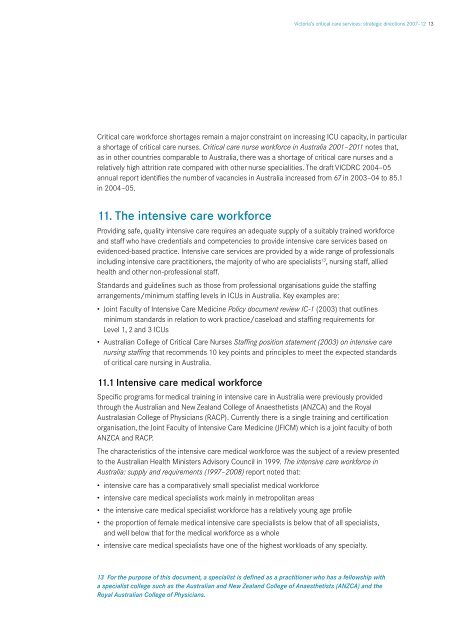Victoria's critical care services Strategic directions 2007–12
Victoria's critical care services Strategic directions 2007–12
Victoria's critical care services Strategic directions 2007–12
Create successful ePaper yourself
Turn your PDF publications into a flip-book with our unique Google optimized e-Paper software.
Victoria’s <strong>critical</strong> <strong>care</strong> <strong>services</strong>: strategic <strong>directions</strong> <strong>2007–12</strong> 13<br />
Critical <strong>care</strong> workforce shortages remain a major constraint on increasing ICU capacity, in particular<br />
a shortage of <strong>critical</strong> <strong>care</strong> nurses. Critical <strong>care</strong> nurse workforce in Australia 2001–2011 notes that,<br />
as in other countries comparable to Australia, there was a shortage of <strong>critical</strong> <strong>care</strong> nurses and a<br />
relatively high attrition rate compared with other nurse specialities. The draft VICDRC 2004–05<br />
annual report identifies the number of vacancies in Australia increased from 67 in 2003–04 to 85.1<br />
in 2004–05.<br />
11. The intensive <strong>care</strong> workforce<br />
Providing safe, quality intensive <strong>care</strong> requires an adequate supply of a suitably trained workforce<br />
and staff who have credentials and competencies to provide intensive <strong>care</strong> <strong>services</strong> based on<br />
evidenced-based practice. Intensive <strong>care</strong> <strong>services</strong> are provided by a wide range of professionals<br />
including intensive <strong>care</strong> practitioners, the majority of who are specialists 13 , nursing staff, allied<br />
health and other non-professional staff.<br />
Standards and guidelines such as those from professional organisations guide the staffing<br />
arrangements/minimum staffing levels in ICUs in Australia. Key examples are:<br />
• Joint Faculty of Intensive Care Medicine Policy document review IC-1 (2003) that outlines<br />
minimum standards in relation to work practice/caseload and staffing requirements for<br />
Level 1, 2 and 3 ICUs<br />
• Australian College of Critical Care Nurses Staffing position statement (2003) on intensive <strong>care</strong><br />
nursing staffing that recommends 10 key points and principles to meet the expected standards<br />
of <strong>critical</strong> <strong>care</strong> nursing in Australia.<br />
11.1 Intensive <strong>care</strong> medical workforce<br />
Specific programs for medical training in intensive <strong>care</strong> in Australia were previously provided<br />
through the Australian and New Zealand College of Anaesthetists (ANZCA) and the Royal<br />
Australasian College of Physicians (RACP). Currently there is a single training and certification<br />
organisation, the Joint Faculty of Intensive Care Medicine (JFICM) which is a joint faculty of both<br />
ANZCA and RACP.<br />
The characteristics of the intensive <strong>care</strong> medical workforce was the subject of a review presented<br />
to the Australian Health Ministers Advisory Council in 1999. The intensive <strong>care</strong> workforce in<br />
Australia: supply and requirements (1997–2008) report noted that:<br />
• intensive <strong>care</strong> has a comparatively small specialist medical workforce<br />
• intensive <strong>care</strong> medical specialists work mainly in metropolitan areas<br />
• the intensive <strong>care</strong> medical specialist workforce has a relatively young age profile<br />
• the proportion of female medical intensive <strong>care</strong> specialists is below that of all specialists,<br />
and well below that for the medical workforce as a whole<br />
• intensive <strong>care</strong> medical specialists have one of the highest workloads of any specialty.<br />
13 For the purpose of this document, a specialist is defined as a practitioner who has a fellowship with<br />
a specialist college such as the Australian and New Zealand College of Anaesthetists (ANZCA) and the<br />
Royal Australian College of Physicians.

















